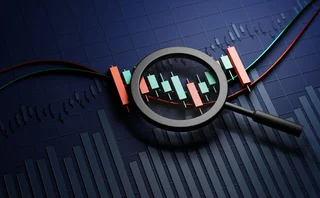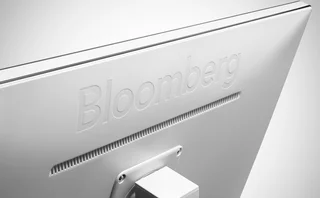
Goldman brings ‘self-service’ pre-trade analytics to FX options
Mobile-based tool allows users to structure and price trades dynamically using data from the cloud

Goldman Sachs has launched a pre-trade analytics tool for vanilla foreign exchange options that is accessible on mobile devices and will allow clients to structure and price their own trades using real-time data from the bank. It is the first step in a plan to make the service cross-asset and to simplify the language used to describe derivatives trades.
Called Visual Structuring, Goldman’s new tool allows users to adjust everything from strikes to maturities and barriers dynamically on a simplified chart before obtaining a view of all the details on the trade, based on pre-calculated, near-live data from its risk system, Sec DB.
That could include anything from the price of the structure to the Greeks, probabilities, breakevens and possible payouts. Trade parameters can be locked – a zero-cost structure, for instance – and adjusted to find the optimal combination of strikes and maturities. The tool is launching with FX options but also covers precious metals options.
Chris Churchman, head of Goldman Sachs’ Marquee - the digital platform for its markets division - says Visual Structuring is a big step forward from Excel-based pricers on single-dealer platforms, which restrict users to structuring and pricing one fixed position at a time.
“Given the developments in technology over the last 20 years, is ‘Excel-on-the-web’ the best paradigm for trade idea generation? It’s ridiculous,” says Churchman.
“Some systems allow you to price grids of variations, scenarios or backtests, but these are hard to scale because [they] use a lot of custom compute. But even these analytics tend to be just bolt-ons to what is, effectively, a very, very old-school, spreadsheet-style pricer,” he adds.
The idea behind the offering is to give users the tools to help them refine their own structures and reduce the time taken to construct trades. For instance, a sell-side trade idea might require several tweaks to tenors and strikes before a client might want to trade it – Visual Structuring allows the client to do this themselves and see the price immediately.
The tool includes historical backtesting information and makes use of star ratings – to show the relative cheapness of a trade, for example, or the proportion of the price that is made up of skew.

Clients can use it to create their own trade ideas and need not ask sales coverage for quotes, thereby reducing information leakage. It also includes a share function so that ideas can be distributed within teams for more input or sent to Goldman’s Marquee Trader single-dealer platform for execution.
Churchman says the plan is to compete in spaces other than execution, which represents less than 1% of the total time taken to put on a trade.
“That’s the only thing everyone’s competing on – price. But the price at inception is just a small part of the overall success of the trade. We want to help clients structure a better trade in the first place, and then monetise it more effectively when they have it on,” he says.
Data for the tool is pre-calculated in the cloud. For each currency pair, Churchman says, the bank calculates thousands of vanilla options at every strike and tenor, and then works out scenarios for each one.
The data is periodically refreshed by pair, but if a user requests an update that new data is also available for the next user who looks at that pair.
“The more people use it, the faster it gets,” he says. “Because we’re using cloud computing, if one user has refreshed all the pricing, everyone else benefits.”
To make Visual Structuring more user friendly, it doesn’t include all possible option parameters, such as whether it is physically or cash settled. Users will still have to call sales coverage or use the single-dealer platform to get a final, firm price on the structure before execution.
Churchman says the broader ambition is to build out the tool to include exotic structures such as target redemption forwards (Tarfs), but these come with added challenges. Pre-pricing thousands of Tarfs, each of which can take up to 20 seconds to calculate, isn’t possible, so the bank is training a neural network with examples of trades and market data to devise a means of approximating the outputs of the pricing models.
“That pricing time goes from between 10 and 20 seconds to 50 milliseconds, which is basically nothing. And the accuracy is good enough for idea generation,” he says.
Given Churchman’s background – he was previously co-head of FX options at UBS before joining Goldman in July last year – it made sense to start with that instrument. But Goldman has ambitions to extend the tool across equities, rates and credit options.
Moving cross-asset, however, means straying into markets with different quoting conventions and jargon than FX. These create barriers to entry that prevent experts in one asset class from dabbling in another – it’s not always clear, for example, which are the liquid expiry dates and strikes that actually trade.
Churchman says the tool will guide users to the most appropriate instruments using more common derivatives terminology that is understood across asset classes. He hopes this will bring in new FX options users, as well as encouraging existing clients to do more.
“We’re trying to create a new language of derivatives. If we get it right, people will start sharing Visual Structuring links a bit like sharing online listings for houses. Sure, you want to see it in person and have a broker walk you through the transaction, but for price discovery and idea generation you want that to be self-service, wherever you are,” he adds.
Only users who have a paid subscription or are part of a corporate subscription are able to print or copy content.
To access these options, along with all other subscription benefits, please contact customer services - www.fx-markets.com/static/contact-us, or view our subscription options here: https://subscriptions.fx-markets.com/subscribe
You are currently unable to print this content. Please contact customer services - www.fx-markets.com/static/contact-us to find out more.
You are currently unable to copy this content. Please contact info@fx-markets.com to find out more.
Copyright Infopro Digital Limited. All rights reserved.
You may share this content using our article tools. Printing this content is for the sole use of the Authorised User (named subscriber), as outlined in our terms and conditions - https://www.infopro-insight.com/terms-conditions/insight-subscriptions/
If you would like to purchase additional rights please email info@fx-markets.com
Copyright Infopro Digital Limited. All rights reserved.
You may share this content using our article tools. Copying this content is for the sole use of the Authorised User (named subscriber), as outlined in our terms and conditions - https://www.infopro-insight.com/terms-conditions/insight-subscriptions/
If you would like to purchase additional rights please email info@fx-markets.com
More on Tech and data
Outlook for e-FX: opportunities and risks for banks
As electronification spreads into new areas of FX trading, banks are under pressure to digitise more of their offerings to remain competitive. The race is now on to automate pricing, trading and hedging in areas such as non-deliverable forwards, swaps…
Why last look needs a new look
Insufficient LP disclosures leave fund managers in the dark on pre-trade costs, says BidFX’s data head
Measuring expected cost models on large FX trades
BestX study assesses factors influencing algo performance on trades over $100m in size
Bloomberg deploys new chatbot tool to Terminal
Offering allows users to surface data and notifications from internal systems without leaving Instant Bloomberg chatrooms
FXPBs see compression tech as key for credit optimisation
FX Markets USA: Providers hope new tech solutions can help replenish credit lines to hedge funds
JP Morgan pulls plug on deep learning model for FX algos
FX Markets USA: Bank turns to less complex models that are easier to explain to clients
US insurers take different paths to hedge FX
Counterparty Radar: Maturity and size of FX forwards trades vary significantly between firms
Corporates’ tech stacks face pressure from rising FX volatility
Treasurers and CFOs are worried about how their FX tech will cope with a potential increase in hedging activity








